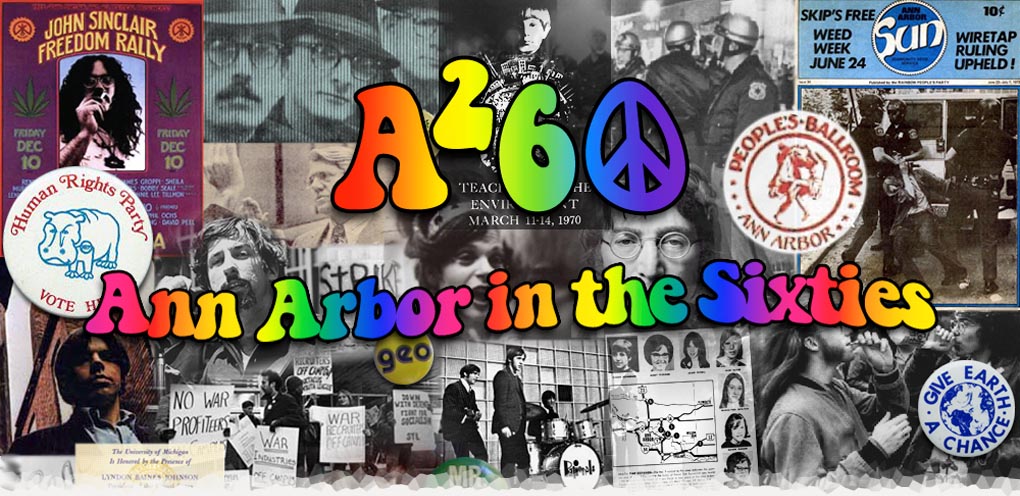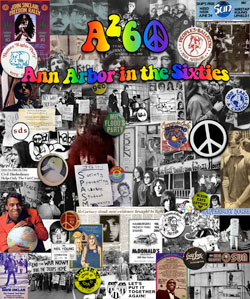
The Michigan History Project is currently preparing the definitive history of Ann Arbor in the 1960s, called collectively A260: Ann Arbor in the Sixties. A260 is a massive preservation effort that entails the gathering of huge amounts of invaluable archival material plus the publication of perhaps a dozen books and also several films, including a dramatization.
Curiously, Ann Arbor doesn't seem to get as much recognition for its contribution to the sea change of the sixties as do other places such as Berkeley or Madison, Wisconsin. But it was just as important to the growth and evolution of the sixties as either of those two cities.
Ann Arbor saw the birth of Students for a Democratic Society – one the biggest and most influential youth groups of the sixties – in 1960, and was home to the SDS leadership for the first half of the decade. Ann Arbor spawned the first "teach-in" of the sixties, in March 1965, about the widening war in a small Southeast Asian country most Americans had never heard of. (That would soon change.) Ann Arborites also played a key role in the establishment of the Peace Corps, following a speech by presidential candidate John F. Kennedy on the steps of the Michigan Union in October 1960.
Ann Arbor was the birthplace of the White Panther Party, which would eventually play an important (although an indirect and highly ironic) role in the downfall of the Nixon administration. In addition, Ann Arbor (not San Francisco) was the city that saw the election of the first openly gay person to public office in the United States in early 1974.
Many important leaders of the sixties movement came out of Ann Arbor, including Tom Hayden, Dick and Mickey Flacks, Bill Ayers, and Carl Oglesby. A host of other notable and interesting people contributed to and were influenced by the social, political, and cultural energy of Ann Arbor during that time, including John Sinclair, Bob Seger, Todd Gitlin, Gilda Radner, Iggy Pop, Larry Brilliant, Ken and Ric Burns, Lawrence Kasdan – as well as countless others who are not as well known but whose contributions were equally as important.
Click here to read more about what happened in Ann Arbor during the 1960s.
A260 will chronicle the contentious transformation of a small Michigan town of stern German heritage, proudly embodying the conservative ideals of mid-century middle America, into an epicenter of social, political, and cultural radicalism in just a few tumultuous years.
It is time now for another major, substantive, broad-themed study of the sixties. Work on A260 proceeds on several fronts, perhaps the most important of which is research.
What originally seemed like an interesting story about the small-town birth of SDS and the Peace Corps has blossomed into an enormous topic that includes dozens of important people and events, the birth and growth of a number of influential social and political movements, as well as pioneering efforts in music, ecology, and avant-garde performance art (with pot smuggling, UFO sightings, and a spate of brutal serial murders thrown in for good measure).
Research has proved to be difficult, however, as it is an unfortunate fact that not much has yet been written about Ann Arbor in the sixties.
So we must find the people who lived through it and ask them about it.
If you count yourself among their number, please get in touch.
We'd also like to hear from people who have photographs, home movies, buttons, fliers, posters, and other memorabilia from Ann Arbor of that time.
Click here to contact the Michigan History Project in regard to A260.
MHP would like to thank everyone who has helped us in our efforts so far. Many important people, famous and otherwise, have given us great encouragement and promised to help in any way they can. Hopefully we will be able to include you among their number.
Ann Arbor in the Sixties. It's a history that we strongly believe is worth preserving – and hope that you do, too.
